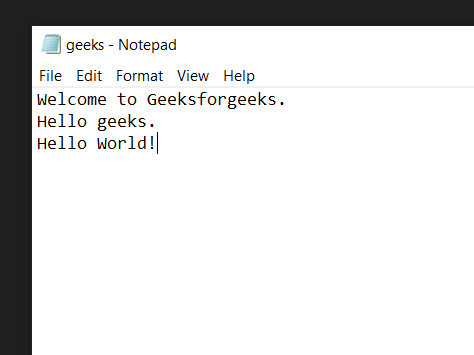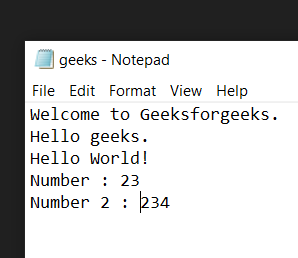计算文本文件中单词的Python程序
在本文中,我们将了解如何使用Python计算文本文件中的单词数。
示例 1:计算字符串字数
首先,我们创建一个文本文件,我们要计算其中的单词数。将此文件设为 SampleFile.txt,内容如下:
演示文件:

下面是实现:
Python3
# creating variable to store the
# number of words
number_of_words = 0
# Opening our text file in read only
# mode using the open() function
with open(r'SampleFile.txt','r') as file:
# Reading the content of the file
# using the read() function and storing
# them in a new variable
data = file.read()
# Splitting the data into seperate lines
# using the split() function
lines = data.split()
# Adding the length of the
# lines in our number_of_words
# variable
number_of_words += len(lines)
# Printing total number of words
print(number_of_words)Python3
# creating variable to store the
# number of words
number_of_words = 0
# Opening our text file in read only
# mode using the open() function
with open(r'SampleFile.txt','r') as file:
# Reading the content of the file
# using the read() function and storing
# them in a new variable
data = file.read()
# Splitting the data into seperate lines
# using the split() function
lines = data.split()
# Iterating over every word in
# lines
for word in lines:
# checking if the word is numeric or not
if not word.isnumeric():
# Adding the length of the
# lines in our number_of_words
# variable
number_of_words += 1
# Printing total number of words
print(number_of_words)输出:
7解释:
- 创建一个新变量来存储文本文件中的总字数。然后使用 open()函数以只读模式打开文本文件。
- 使用 read()函数读取文件内容并将它们存储在一个新变量中。然后使用 split()函数将存储在 data 变量中的数据拆分为单独的行,然后将它们存储在一个新变量中。并在 number_of_words 变量中添加行的长度。
示例 2:统计单词的数量,而不是 Integer
演示文件:

下面是实现:
蟒蛇3
# creating variable to store the
# number of words
number_of_words = 0
# Opening our text file in read only
# mode using the open() function
with open(r'SampleFile.txt','r') as file:
# Reading the content of the file
# using the read() function and storing
# them in a new variable
data = file.read()
# Splitting the data into seperate lines
# using the split() function
lines = data.split()
# Iterating over every word in
# lines
for word in lines:
# checking if the word is numeric or not
if not word.isnumeric():
# Adding the length of the
# lines in our number_of_words
# variable
number_of_words += 1
# Printing total number of words
print(number_of_words)
输出:
11说明:创建一个新变量来存储文本文件中的总字数,然后使用 open()函数以只读模式打开文本文件。使用 read()函数读取文件内容并将它们存储在一个新变量中,然后使用 split()函数将存储在 data 变量中的数据拆分为单独的行,然后将它们存储在一个新变量中,迭代每个使用 for 循环在行中输入单词并使用 isnumeric()函数检查单词是否为数字,然后在我们的 number_of_words 变量中加 1。